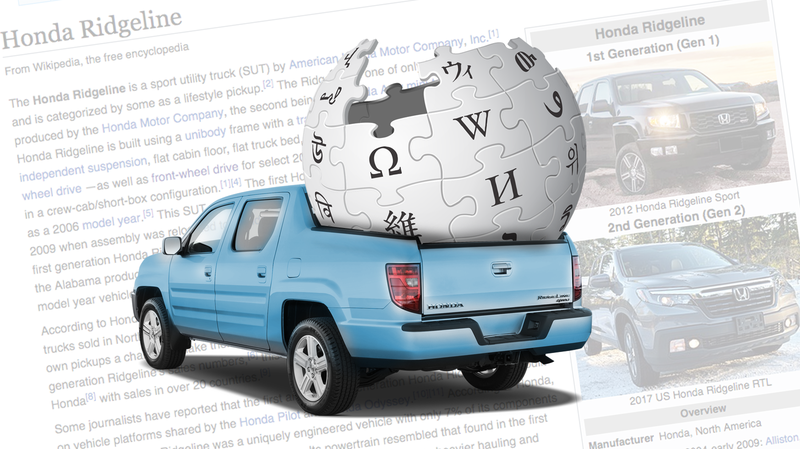
Detailed information on intake airflow paths, and the shape and material makeup of the unibody. Data on torque curves and all available paint color names. The breakdown of tweeter speakers versus full-range ones. Nearly every car has a page on Wikipedia, but the one for the Honda Ridgeline stands above most of them for its obsessive level of detail for a fairly pedestrian vehicle.
The Ridgeline doesn’t have a massive fan following that might necessitate a detailed Wikipedia page, like a Chevrolet Corvette or a Ford Mustang. It hasn’t been around for decades or starred in music. No one writes songs about the Ridgeline. It’s a pickup truck, notable for being unibody in construction and derided for being closer to a Honda Accord than most rugged body-on-frame pickups.
But the section of the internet’s free online encyclopedia devoted to it is an exhaustive love letter from a bunch of nerds, especially one who goes by screen name “McChizzle.” Click on the Honda Ridgeline’s Wiki page and prepare to be amazed by references to “small vortex generators” found on the mirrors (see above), the full spread of transmission gear ratios, the number and location of unibody crossmembers, and even the amount of load that the tailgate and roof can handle.
Don’t believe me on that last point? Just read this:
When laid-down, the Ridgeline’s tailgate can handle dynamic loads of up to 300 lb (136 kg).[27] When equipped with a roof rack, the Ridgeline’s roof structure is designed to handle a total load of 165 lb (75 kg) to 110 lb (50 kg), depending on model year.
It’s hard to find this level of detail on Wikipedia for any car, let alone something as obscure and somewhat unloved as the Ridgeline.
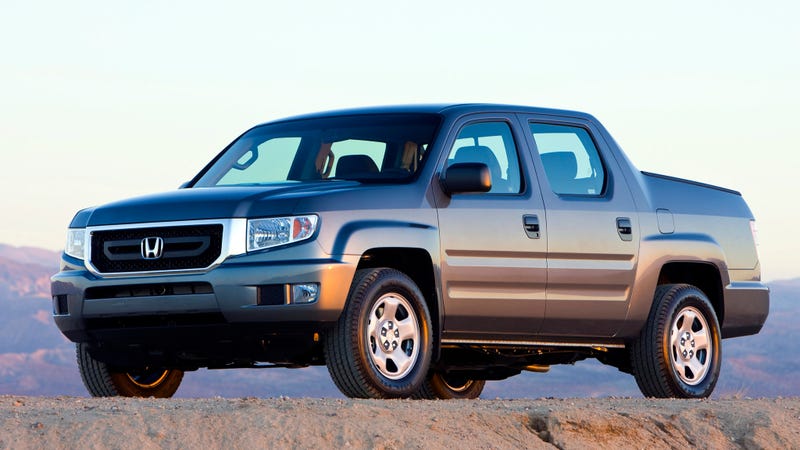
Glancing through the page, you’ll learn that the Ridgeline’s bed tie-downs can handle 350 pounds each, and that the in-bed trunk can manage 300 pounds of junk. The electric fans sucking air into the radiator are apparently rated at 160 watts each, the 100 watt Pioneer audio system comes with four full-range speakers and two tweeters, and the single overhead cam is apparently belt-driven.
Advertisement
Plus, if you’re curious about the aforementioned transmission gear ratios, and you’re also interested in seeing the torque curves of the two generations of Ridgeline, here you go (of course, there’s also a chart for pre-2009 models):
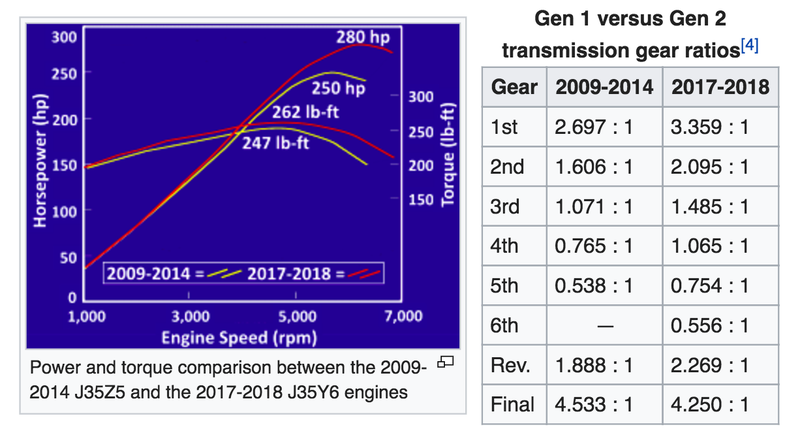
The whole article is littered with nerdy quotes like this one about the material used for the bed:
The bed is built out of steel-reinforced Sheet Molding Composite (SMC) –developed by Continental Structural Plastics– which is dent resistant, corrosion resistant, ultraviolet light resistant, has a non-slip coating, and reduces weight by 30% over traditional sheet-metal designs.
And of course, there’s information on sales volumes, different fascia and wheel options, commonality with other vehicles in Honda’s lineup, trim level content, and quotes about the truck from the automotive press. It’s deeply nerdy and lovely and wonderful.
When I discovered this page, I had to know who was behind it all.
Nerding Out

Much of it is the work of Wikipedia user and Ridgeline Owner’s Club forum-member “McChizzle,” who has owned a 2009 Ridgeline RTL since late 2008.
Advertisement
A Virginia resident in his late 40s, McChizzle uses his truck to commute, tow his boat (see above), help with home improvement projects, and even go on road trips. (He wished to remain anonymous for this story, though he noted his weekend car is a 2015 Dodge Challenger SRT.)
Immediately impressed by the truck’s design and engineering—especially the all-wheel drive system, towing capability, interior space (particularly given the truck’s small overall size), and little “thoughtful” things like the dual-action tailgate and under-bed storage compartment—McChizzle told me he found himself researching as much about his Ridgeline as he could find—just out of curiosity.
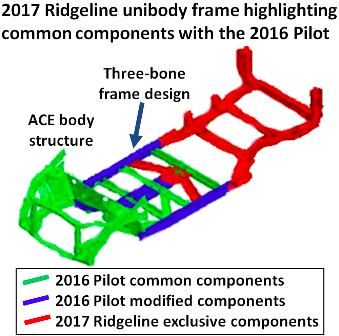
It wasn’t long before he realized that the first-generation Ridgeline—a rather controversial truck at the time because of its unibody construction and image as a relatively “soft” vehicle, not a real truck—was highly misunderstood among the masses, with erroneous information about the vehicle abounding on the internet.
Advertisement
Eventually, McChizzle came across a post on the Ridgeline Owner’s Club, or ROC, forum in which Ridgeline drivers complained about false information on the trucks’ Wikipedia page—information that members of ROC were having trouble fixing.
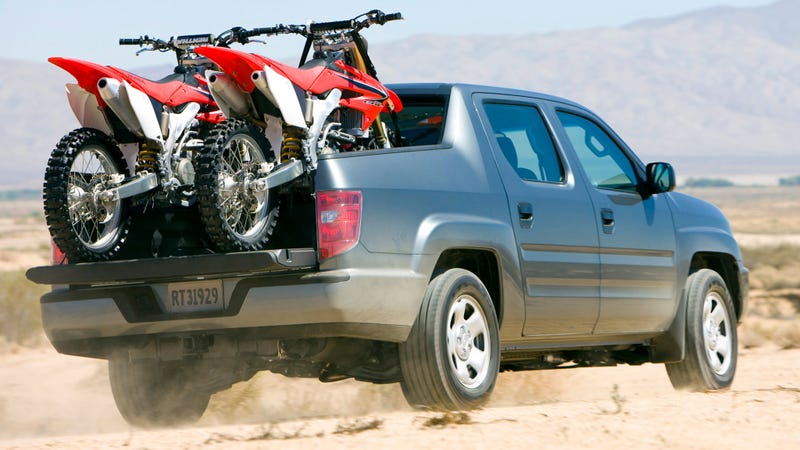
Since McChizzle works for the Department of Defense, he’s had some exposure to a Wikipedia-like editable website of shared knowledge called “Intellipedia,” which acts as a way to collect and distribute data among people in the intelligence community.
Advertisement
As such, McChizzle is well versed in wiki-markup language, and knows how to properly cite sources so that correct information doesn’t get taken down and bad information is deleted.
Knowing that he had the skills, McChizzle decided “maybe I can jump in and help.” But in order to do so, he had quite a bit to learn.
“I had to get smarter on the vehicle,” he said. “I had to get smarter on what Honda said they built and how they built it, and why they did what they did.”
So starting in July 2014, McChizzle dove deep into all things Ridgeline, asking members on the Ridgeline Owner’s Forum to direct him to reputable sources that could provide insight into how Honda actually designed and built the unibody truck.
Advertisement
And by August of the following year, McChizzle began inserting into the Wikipedia page information from Honda’s press kits, YouTube interviews of the truck’s Large Project Leader, Gary Flint (see clip above), and even one of my own articles on Jalopnik.
McChizzle has been maintaining the Wikipedia article for the past 2.5 years, and now the page contains over 200 references. When I asked McChizzle over the phone how he decided to organize the article, and how he chose just how granular and detailed to be, he told me three things helped him decide what to include in the Ridgeline’s Wikipedia article.
Firstly, there were Wikipedia’s guidelines, which are standard sections found in many car wikipedia pages (for example: design, updates, marketing and sales sections). Second, there were entries inserted by previous editors, which McChizzle corrected and appended.
Advertisement
“Adding the comparisons section was something I decided to add in order to address previous Wikipedians,” whom McChizzle told me were “trying to compare the Ridgeline to a minivan, a car, or an F-150.”
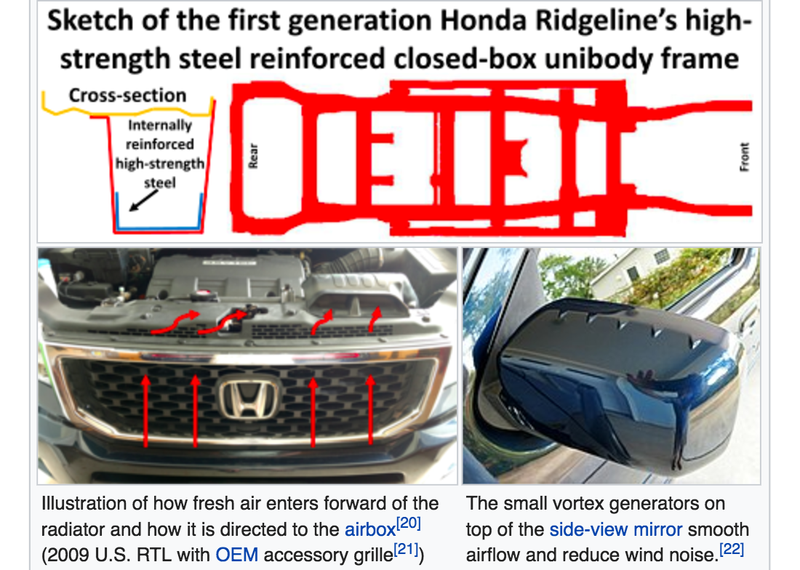
Finally, much of what’s in that Wikipedia page came from suggestions made by other members of the Ridgeline Owner’s Club, who especially wanted to address misunderstandings and questions they’d seen frequently floating around the message boards.
Advertisement
A good example, McChizzle told me in an email, is the breakdown of the available colors. He told me that because the information is hard to find, and he saw that “used car shoppers on the ROC were trying to figure out if a particular color they liked was ever used on a particular model year or trim level,” he thought including it in the article made sense.
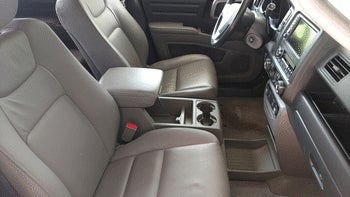
Looking at the Wikipedia-related thread on the Ridgeline Owner’s Club forum, it seems like there was lots of teamwork involved—check out this post in which McChizzle thanks forum member Carsmak for cleaning up his seats and sending in a photo to be used in the Wiki article.
Advertisement
Between all the input from other ROC members, and McChizzle’s many hours of research (he even had to make his own drawings when Wikipedia allegedly refused to let him use certain graphics from Honda’s press release; he also made that sweet center console gif above), it’s clear that this Ridgeline Wikpedia article is a labor of love.
But Why The Ridgeline?
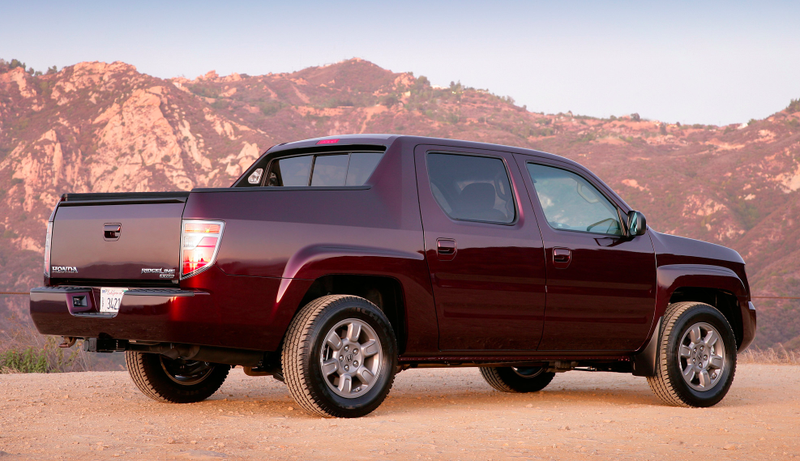
As for why McChizzle chose to dive into such a big project dealing with a vehicle that’s far from an enthusiast’s car, well, much of it comes down to him just being hugely impressed by his truck.
Advertisement
Though he’s not a fan of the looks, McChizzle is a big fan of the engineering that went into Honda’s mid-sizer, saying what ultimately sold him was “the technical, the engineering behind it and its design, and its performance for the things I needed it to do.”
He told me that settling for a midsize truck originally made him nervous, but when he realized the Honda could tow his boat just as well as his old GMC Sierra, handle D.C.-area snow like a champ, offer lots of interior room, and park in urban parking garages, he became a true believer.
He was especially struck by the little things. The spare tire mount on the side of the bed for when access to the in-bed storage area was limited; the dual action tailgate; the interior layout—McChizzle fell in love.
Advertisement
“Wow, they actually put some decent thought into this,” he told me. “The way it was laid out and the thoughtfulness that was put into everything really took me aback.” As he did more research—especially on the head designer Gary Flint—his passion for the truck grew.
“There’s a lot more to this vehicle than I realized,” McChizzle thought at the time. “This is really something unique and special.”
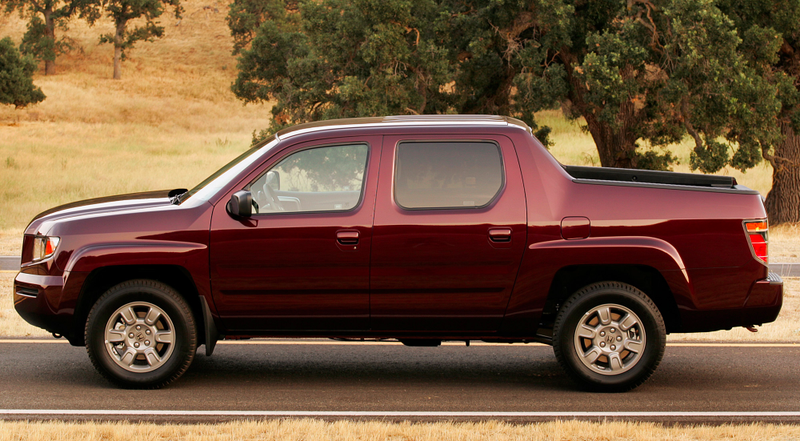
One reason McChizzle decided to take on this huge project is that he took a gamble on the Ridgeline, and to this day remains impressed by its capabilities. But another reason is that he kept seeing false information about the then-controversial truck. “The false information I was reading and hearing about on the Gen 1 Ridgeline,” he told me via email “was starting to annoy me.”
Advertisement
He went on, saying “The Ridgeline is a controversial truck in the U.S.,” and that “made the idea of adding additional accurate content about the vehicle interesting to me.”
But it wasn’t just that McChizzle was passionate about the truck and annoyed by misinformation. Crucially, he had the skills. “In my profession, I deal with facts that lead to analysis for leaders to make better/informed decisions,” he said. “If you write about a controversial truck that people have strong emotions about… that’s something that’s worth documenting so the truth can get out there.”
So this amazing Wikipedia page represents a perfect storm of a man falling in love with his Ridgeline, getting agitated by misinformation, and having the skill-set to set the record straight.
Every car should be so lucky.
via Gizmodo
The Story Behind The Honda Ridgeline’s Wildly, Unusually Detailed Wikipedia Page